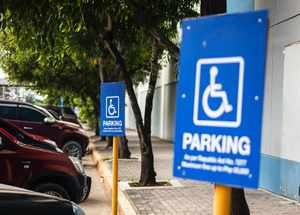While many people never have to consider the barriers that restrict them while shopping, those with disabilities may decide to not shop at a store based on those very barriers. From narrow parking spaces and aisleways to tall shelving units and checkout counters, barriers keep those with disabilities from being served adequately if at all.
From narrow parking spaces and aisleways to tall shelving units and checkout counters, barriers keep those with disabilities from being served adequately if at all.
In 1992, Congress established the Americans with Disabilities Act (ADA) which set accessibility requirements that businesses need to meet in order to serve the public as required by their civil rights.
The ADA is merely a starting point for what stores can do to accommodate those with disabilities. If you want to set your store above the competition when it comes to accessibility, go beyond what the ADA requires.
Disabled Shoppers Need Access
First and foremost, your disabled shoppers need to get in the door. If you have a parking lot, you know you’re required to have designated spots that meet size requirements for those using wheelchairs, crutches, scooters, or assistants. You also know how to address other architectural barriers like curbs, steps, doorknobs, and door widths.
What the ADA doesn’t require are the courtesies you can easily provide for customers to shop at your store:
- Maintenance is critical outside your building.
- Potholes and cracks can easily throw patrons off balance when they’re using crutches, canes, or walkers.
- Keep the outside of your business clean.
- Rubbish scattered about is just another obstacle for many with a disability.
- Posting your store’s phone number nearby the designated disabled parking spots helps as well.
This allows a disabled patron to telephone if additional assistance is needed to enter the store or if curbside sales can be negotiated.
How to Help Disabled Shoppers as a Shop Owner
Inside, be sure that aisleways are wide enough for wheelchairs and other convalescent devices to maneuver as set forth by the ADA. Having moveable racks and walls can help manage this while maintaining merchandising goals. If your store sells apparel, you probably have fitting rooms that follow the regulations outlined by the ADA.
Other steps can be taken to improve in this area. Besides having salespeople check back with the customer, install a call box, buzzer, or bell in the fitting room. Using this device, the customer can easily summon help when necessary.
Train your staff to politely approach those with a recognized disability and offer shopping assistance. It may be difficult for those with disabilities to reach the products they want, but your employees shouldn’t wait to see the shopper struggle before offering help. Not every disability is blatant though. You may have a hard time noticing that someone has a disability such as deafness or arthritis.
Because of this, impress upon your staff the need to welcome each and every customer and to check back with them to see if they need help. Encourage employees to read aloud product labels for those who may be visually impaired.
During this part of your staff’s training, question your employees about special skills they may have. You may find someone who is proficient in American Sign Language or someone who has worked as a caregiver. Their knowledge can be a tremendous help.
In Conclusion
Checking out can be one of the most troublesome areas for shoppers with disabilities. Following the ADA’s rules eliminates many physical barriers. A handy clipboard, lapboard, or low auxiliary counter helps make purchases much more accessible for those with wheelchairs, but will those shoppers be able to make it out of the store on their own?
Carrying out shopping bags for customers doesn’t have to be a thing of the past; it can be a simple service that makes you stand out among the other stores for disabled shoppers.
